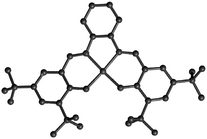Intramolecularly hydrogen-bonded versus copper(ii) coordinated mono- and bis-phenoxyl radicals†
Abstract

* Corresponding authors
a
Laboratoire de Chimie Biomimétique, LEDSS, UMR CNRS 5616, ICMG FR CNRS 2607, Université J. Fourier, BP 53, 38041 Grenoble cedex 9, France
E-mail:
Fabrice.Thomas@ujf-grenoble.fr
Fax: +33 4 7651 4836
b High Magnetic Field Laboratory, CNRS-MPI UPR 5021, BP 166, 38042 Grenoble Cedex 9, France
c LEOPR, UMR CNRS 5630, ICMG FR CNRS 2607, Université J. Fourier, BP 53, 38041 Grenoble Cedex 9, France

 Please wait while we load your content...
Something went wrong. Try again?
Please wait while we load your content...
Something went wrong. Try again?
F. Thomas, O. Jarjayes, C. Duboc, C. Philouze, E. Saint-Aman and J. Pierre, Dalton Trans., 2004, 2662 DOI: 10.1039/B406009A
To request permission to reproduce material from this article, please go to the Copyright Clearance Center request page.
If you are an author contributing to an RSC publication, you do not need to request permission provided correct acknowledgement is given.
If you are the author of this article, you do not need to request permission to reproduce figures and diagrams provided correct acknowledgement is given. If you want to reproduce the whole article in a third-party publication (excluding your thesis/dissertation for which permission is not required) please go to the Copyright Clearance Center request page.
Read more about how to correctly acknowledge RSC content.
 Fetching data from CrossRef.
Fetching data from CrossRef.
This may take some time to load.
Loading related content
